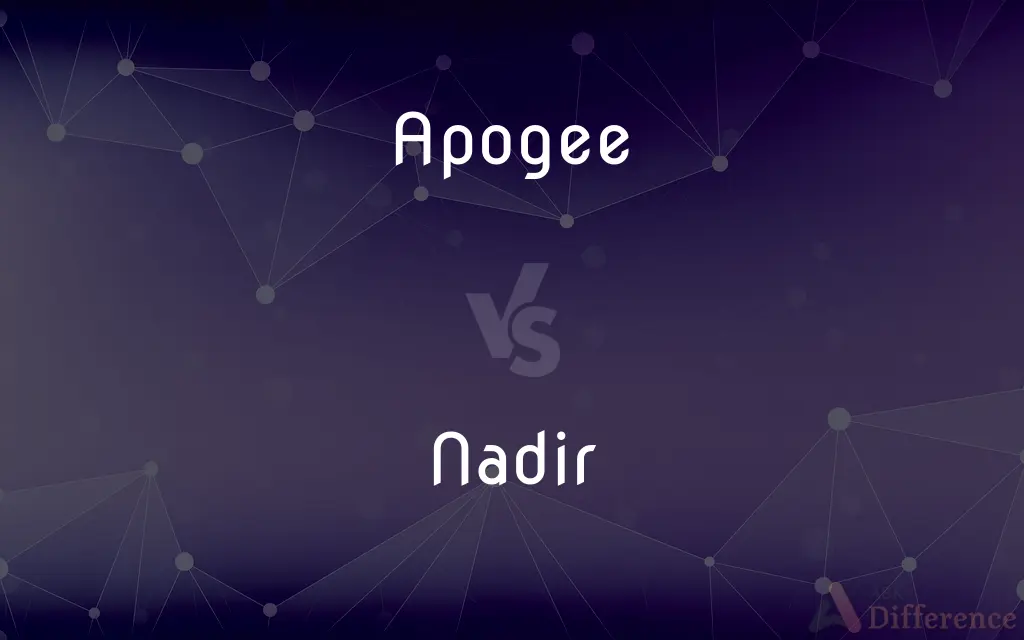Apogee vs. Nadir — What's the Difference?
By Urooj Arif & Fiza Rafique — Updated on May 2, 2024
Apogee refers to the point in the orbit of an object where it is furthest from the Earth, typically used in astronomy and spaceflight, whereas nadir is the point directly below a position, representing the lowest point figuratively or literally.

Difference Between Apogee and Nadir
Table of Contents
ADVERTISEMENT
Key Differences
The term "apogee" is used primarily in the context of astronomy and space science to describe the point in the orbit of a moon or satellite where it is farthest from the Earth. This contrasts with "nadir," which in astronomy refers to the point on the celestial sphere directly beneath an observer, opposite the zenith.
In orbital mechanics, the apogee is critical for calculations regarding satellite paths around Earth, affecting aspects like satellite speed and orbital period. On the other hand, the nadir does not involve orbital mechanics but is used to describe directional orientation relative to the Earth’s surface, particularly in fields like geology and surveying.
In a more figurative sense, "apogee" can denote the highest or most distant point in terms of development or success, often used metaphorically in literature or rhetoric. Conversely, "nadir" is commonly used to represent the lowest point of a person's fortunes or morale, highlighting its utility beyond literal geographical descriptions.
Apogee’s importance extends into communication technology, especially in discussions about satellite communication, where the distance at apogee can affect signal strength and quality. In contrast, nadir's role in communication contexts is less direct, more about alignment and positioning relative to the Earth.
References to "reaching one’s apogee" are seen as achieving peak potential, while "hitting the nadir" often connotes a need for significant change or recovery, demonstrating how both terms are adapted into broader dialogues beyond their scientific origins.
ADVERTISEMENT
Comparison Chart
Definition
Farthest point from Earth in orbit
Directly below a position on Earth
Used in
Astronomy, spaceflight
Astronomy, geology, surveying
Figurative Use
Peak of achievement
Lowest point of fortune
Impact on
Satellite mechanics, communications
Directional orientation, morale
Cultural Context
Achievement, distance
Decline, orientation
Compare with Definitions
Apogee
Often used to describe the highest point or climax.
The artist’s career hit its apogee with that spectacular public performance.
Nadir
The point on the celestial sphere directly below an observer.
The geologist calculated the nadir to ensure accurate data collection.
Apogee
In space missions, relates to when a spacecraft is furthest from Earth.
The mission's success was crucially dependent on maneuvers at apogee.
Nadir
Represents the lowest point in a person’s fortunes or spirits.
After several failed investments, he found himself at his nadir.
Apogee
Used metaphorically to imply reaching full potential.
The novel was considered the apogee of the writer’s literary genius.
Nadir
Used in surveying to reference the downward vertical line.
Accurate nadir point measurement is crucial for underground mapping.
Apogee
Important in discussions about Earth's satellite operations.
Communication satellites are placed in geostationary orbits where the apogee and perigee are equal.
Nadir
In astronomy, it contrasts with the zenith.
During the observation, the astronomer noted the star passed through the nadir.
Apogee
The point in an orbit most distant from the center of the Earth.
The satellite reaches its apogee three hours after launch.
Nadir
Symbolically used to describe severe decline.
The company's stocks hit their nadir following the scandal.
Apogee
(Astronomy)The point in an orbit around the planet Earth where the orbiting body is farthest from the planet.
Nadir
The nadir (; also UK: ; Arabic: نظير, romanized: naẓīr, lit. 'counterpart') is the direction pointing directly below a particular location; that is, it is one of two vertical directions at a specified location, orthogonal to a horizontal flat surface there. Since the concept of being below is itself somewhat vague, scientists define the nadir in more rigorous terms.
Apogee
The analogous point in an orbit around a celestial body other than Earth. Not in technical use.
Nadir
(Astronomy) A point on the celestial sphere directly below the observer, diametrically opposite the zenith.
Apogee
The farthest or highest point; the apex:"The golden age of American sail, which began with the fast clipper ships in 1848, reached its apogee in the Gold Rush years"(Los Angeles Times).
Nadir
The lowest point
The nadir of their fortunes.
Apogee
(astronomy) The point, in an orbit about the Earth, that is farthest from the Earth: the apoapsis of an Earth orbiter.
Nadir
The point of the celestial sphere, directly opposite the zenith; inferior pole of the horizon; point of the celestial sphere directly under the place of observation.
Apogee
The point, in an orbit about any planet, that is farthest from the planet: the apoapsis of any satellite.
Nadir
(figuratively) The lowest point; time of greatest depression.
Apogee
The point, in any trajectory of an object in space, where it is farthest from the Earth.
Nadir
(astronomy) The axis of a projected conical shadow; the direction of the force of gravity at a location; down.
The nadir of the sun is the axis of the shadow projected by the Earth.
Apogee
(figuratively) The highest point.
Nadir
An empty box added beneath a full one in a beehive to give the colony more room to expand or store honey.
Apogee
That point in the orbit of the moon which is at the greatest distance from the earth.
Nadir
To extend (a beehive) by adding an empty box at the base.
Apogee
Fig.: The farthest or highest point; culmination.
Nadir
That point of the heavens, or lower hemisphere, directly opposite the zenith; the inferior pole of the horizon; the point of the celestial sphere directly under the place where we stand.
Apogee
A final climactic stage;
Their achievements stand as a culmination of centuries of development
Nadir
The lowest point; the time of greatest depression.
The seventh century is the nadir of the human mind in Europe.
Apogee
Apoapsis in Earth orbit; the point in its orbit where a satellite is at the greatest distance from the Earth
Nadir
An extreme state of adversity; the lowest point of anything
Nadir
The point below the observer that is directly opposite the zenith on the imaginary sphere against which celestial bodies appear to be projected
Common Curiosities
What is the significance of apogee in satellite communication?
In satellite communication, the apogee affects signal propagation distances and therefore impacts communication latency and quality.
What happens when a satellite reaches its apogee?
When a satellite reaches its apogee, it is at its farthest point from Earth, which can affect its orbital speed and visibility from the Earth.
How is nadir used in professional settings?
Nadir is used in surveying and geology to determine precise orientation or positioning relative to the Earth's surface.
How do metaphoric uses of apogee and nadir influence language?
Metaphorically, these terms enrich language by allowing abstract concepts of high and low points to be discussed in varied contexts.
What are the technical requirements for calculating apogee?
Calculating apogee requires understanding of orbital mechanics, including velocity and gravitational forces of Earth.
How does the concept of nadir apply in everyday life?
Nadir is often used metaphorically to describe someone's lowest point in life, such as failure or depression.
Can the terms apogee and nadir be used interchangeably?
No, apogee and nadir refer to very different concepts; apogee is about distance in orbit, while nadir refers to a position directly underneath.
Are there any specific industries where nadir is particularly important?
Yes, in the mining and construction industries, nadir measurements are vital for accurate underground work.
How do different cultures interpret the concepts of apogee and nadir?
Cultural interpretations vary; some may see apogee as a symbol of success, while nadir might be viewed with negativity or as an opportunity for renewal.
What is the importance of knowing the nadir in astronomy?
Knowing the nadir helps astronomers align telescopes and track celestial bodies relative to the observer’s position.
How do you determine the apogee of a satellite?
The apogee can be determined using tracking data and mathematical calculations based on the laws of orbital dynamics.
Is there a physical significance to the nadir outside of observational contexts?
Yes, in surveying and construction, nadir is crucial for aligning equipment and measuring depths.
What role does apogee play in the lifecycle of a satellite?
Apogee determines the farthest extent of a satellite’s orbit, influencing its orbital period and the coverage area on Earth.
What is the impact of hitting nadir on a business?
Hitting nadir can lead to significant reassessment and strategic overhaul to recover from a low point.
What lessons can be learned from reaching the apogee in a career?
Reaching an apogee can provide insights into maintaining success and planning future endeavors to sustain or extend peak performance.
Share Your Discovery

Previous Comparison
Subjugation vs. Subordination
Next Comparison
Maleficent vs. MalfeasanceAuthor Spotlight
Written by
Urooj ArifUrooj is a skilled content writer at Ask Difference, known for her exceptional ability to simplify complex topics into engaging and informative content. With a passion for research and a flair for clear, concise writing, she consistently delivers articles that resonate with our diverse audience.
Co-written by
Fiza RafiqueFiza Rafique is a skilled content writer at AskDifference.com, where she meticulously refines and enhances written pieces. Drawing from her vast editorial expertise, Fiza ensures clarity, accuracy, and precision in every article. Passionate about language, she continually seeks to elevate the quality of content for readers worldwide.
















































